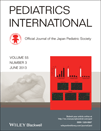Clinical spectrum of cleidocranial dysplasia in a family with twins
Abstract
Cleidocranial dysplasia (CCD) is a rare congenital defect of autosomal dominant inheritance, primarily affecting bones that undergo intra-membranous ossification. Herein is reported the case of monozygotic male 13-year-old twins with typical features of this syndrome, such as large wide-open fontanels, abnormal clavicles with narrow, sloping shoulders that can be apposed at the midline, short stature, mid-face hypoplasia, multiple supernumerary teeth, and skeletal anomalies. Their physical appearance led to the diagnosis of CCD. Genetic analysis found a C–T exchange in exon 2 at cDNA position 568, which changes the codon CGG for arginine to TGG for tryptophan (R190W) of the runt-related transcription factor 2 RUNX2 gene. CCD should be suspected in patients with persistence of the widely open anterior fontanels and sutures, short stature, and poor clavicles, calvarium, or teeth. Timely recognition and hereditary tendency counseling is required and useful because of the possibility of covert transmissibility and sporadic genetic mutation.




